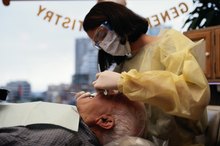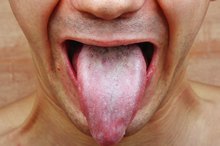What does fact checked mean?
At Healthfully, we strive to deliver objective content that is accurate and up-to-date. Our team periodically reviews articles in order to ensure content quality. The sources cited below consist of evidence from peer-reviewed journals, prominent medical organizations, academic associations, and government data.
- Journal of Clinical Periodontology: Measurement of Prostaglandin E in Crevicular Fluid
- Journal of Clinical Periodontology: Measurement of Prostaglandin E in Crevicular Fluid
The information contained on this site is for informational purposes only, and should not be used as a substitute for the advice of a professional health care provider. Please check with the appropriate physician regarding health questions and concerns. Although we strive to deliver accurate and up-to-date information, no guarantee to that effect is made.
Alcohol Use & Periodontal Disease
According to Dental Health and Alcohol Use, alcohol consumption is associated with the irritation of gums, tongue and oral tissues. Periodontitis is a common, chronic disease affecting 50 percent of U.S. adults older than 30. It is a bacterial infection that causes the destruction of the supporting structures of the teeth. If it is not treated, it will lead to tooth loss. There have been only a few prospective studies on alcohol use and periodontitis. Waranuch Pitiphat found men who drank regularly were at an 18 to 27 percent increased risk of periodontal disease. The risk appears to be dose related.
Alcohol and Periodontitis
According to Gyongyi Szabo, alcohol impairs the body's primary immunologic defense mechanisms to fight infection. Consequently, bacterial overgrowth and increased penetration into gingival tissues can occur. According to Mine Tezal, consumption of 10 or more drinks per week results in higher periodontitis risk compared to those who consume fewer than 10 drinks per week 1. According to Sara G. Grossi, increasing alcohol consumption from five units to 20 units a week increases the risk of periodontal disease from 10 percent to 40 percent 1. Alcohol causes dehydration of the mouth, so bacteria are not washed away by saliva, and plaque formation occurs faster.
- According to Gyongyi Szabo, alcohol impairs the body's primary immunologic defense mechanisms to fight infection.
- Consequently, bacterial overgrowth and increased penetration into gingival tissues can occur.
Periodontitis
How to Remove Tooth Tartar at Home
Learn More
Periodontal disease is caused by three or more presumed disease-causing periodontal pathogens. The disease is categorized as mild, moderate or severe. It damages the bone and connective tissue that supports the teeth. When pockets around the tooth become 4mm deep on probing, the tooth is at risk for infection. When pockets are 6mm to 7mm or more and there is attachment loss, the tooth is at risk for falling out. The greater the number of teeth lost, the higher the extent of severe periodontal disease.
Steve Offenbacher found people with gingivitis had low levels of prostaglandin E2 in gingival crevicular fluid (CF-PGE2), while people with periodontitis had higher CF-PGE2 levels 3. PGE2, an inflammatory biomarker, can differentiate between these two conditions. Gingivitis is a precursor to periodontitis.
- Periodontal disease is caused by three or more presumed disease-causing periodontal pathogens.
- When pockets are 6mm to 7mm or more and there is attachment loss, the tooth is at risk for falling out.
Periodontitis Progression
Many factors influence the progression of periodontitis, including individual characteristics, social and behavioral factors, genetics, tooth factors and bacterial composition of the biofilm around the tooth. Children of parents who have periodontitis have been found to be 12 times more likely to have the bacteria that cause plaque and periodontal disease. Social and behavioral factors include cigarette smoking, lower socioeconomic status, poorer nutrition, psychological factors and excessive alcohol consumption.
Prevention/Solution
How to Use Dental Tools at Home to Remove Plaque
Learn More
Practice good home health care every day. Brush under the gums with an electric toothbrush, floss, stimulate the gums with a rubber-tipped stimulator, and gargle with Listerine antiseptic mouthwash. Limit alcohol consumption (five units per week) to decrease periodontal risk 1. Limit sugar in your diet to prevent bacterial overgrowth. Drink seven glasses of water per day to increase saliva to help clear bacteria and slow plaque production.
- Practice good home health care every day.
- Drink seven glasses of water per day to increase saliva to help clear bacteria and slow plaque production.
Treatment
Scaling and root planning is the gold standard for plaque removal. Arestin (minocycline powder, 1mg) applied directly to periodontal pockets has been approved by the FDA as an addition to scaling and root-planing procedures for reduction of pocket depth in patients with adult periodontitis. Ultimately, surgery may be required.
Related Articles
References
- Journal of Dental Research: Alcohol Consumption Increases Periodontitis Risk
- "Consequences of Alcohol Consumption on Host Defence"; Alcohol & Alcoholism; Szabo G; Nov.-Dec. 1999
- Journal of Clinical Periodontology: Measurement of Prostaglandin E in Crevicular Fluid
- Types of Gum Disease. American Academy of Periodontology. https://www.perio.org/consumer/types-gum-disease.html
- What Is a Periodontist? Canadian Academy of Periodontology. http://www.cap-acp.ca/en/perio/periodontist.htm
Writer Bio
Based in New Jersey, John Riefler has been writing since 1987. His articles have appeared in "MD Magazine," "Emergency Medicine" and "Hospital Practice." Riefler holds a Bachelor of Science in biology from Bucknell University, a Master of Science in microbiology from the Medical University of South Carolina and a medical doctorate from St. George's University School of Medicine.









